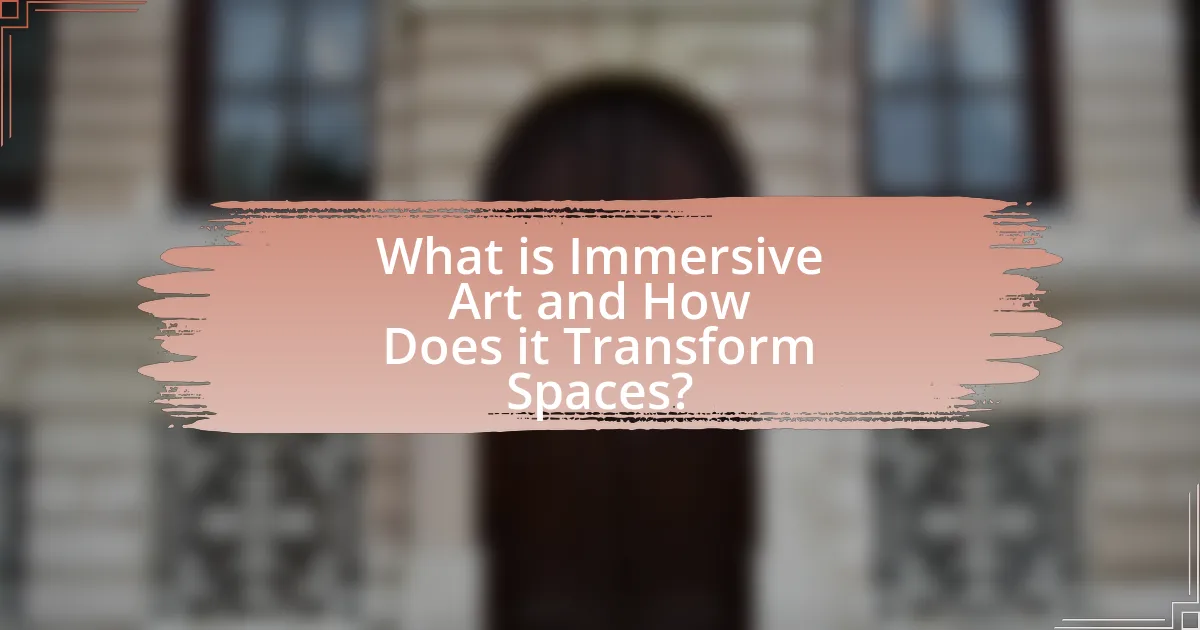Immersive art is a contemporary form of artistic expression that transforms physical spaces into interactive, multi-sensory environments, engaging audiences as active participants. This article explores the definition, characteristics, and significance of immersive art, highlighting how technology, such as virtual reality and projection mapping, enhances viewer experiences. It examines the differences between immersive and traditional art forms, the emotional responses elicited by immersive installations, and the challenges faced by curators in implementing these exhibitions. Additionally, the article discusses future trends and best practices for creating successful immersive art experiences, emphasizing the importance of audience engagement and innovative technology in shaping contemporary art.

What is Immersive Art and How Does it Transform Spaces?
Immersive art is a form of artistic expression that engages the audience in a multi-sensory experience, often utilizing technology, sound, and visual elements to create an interactive environment. This type of art transforms spaces by altering the perception of physical locations, allowing viewers to become active participants rather than passive observers. For instance, installations like TeamLab’s “Borderless” in Tokyo utilize projection mapping and interactive elements to create a fluid, ever-changing environment that encourages exploration and interaction. Such transformations can enhance emotional responses and foster a deeper connection between the audience and the artwork, as evidenced by studies showing increased engagement levels in immersive environments compared to traditional art displays.
How is Immersive Art Defined in Contemporary Contexts?
Immersive art is defined in contemporary contexts as an interactive and participatory experience that engages the audience in a multi-sensory environment. This form of art often utilizes technology, such as virtual reality, projection mapping, and soundscapes, to create spaces where viewers can become part of the artwork itself. For instance, exhibitions like TeamLab Borderless in Tokyo exemplify this definition by allowing visitors to interact with digital installations that respond to their movements, thereby transforming the traditional boundaries between art and audience.
What are the key characteristics of Immersive Art?
Immersive art is characterized by its ability to engage the audience through interactive and sensory experiences. This form of art often utilizes technology, such as virtual reality or projection mapping, to create environments that envelop viewers, making them active participants rather than passive observers. Additionally, immersive art frequently incorporates elements of storytelling, allowing for emotional connections and personal interpretations. The use of space is also crucial, as immersive art transforms physical environments into multi-dimensional experiences that challenge traditional boundaries of art. These characteristics are evident in exhibitions like TeamLab’s “Borderless,” which combines digital art with interactive installations, demonstrating how immersive art can redefine viewer engagement and spatial interaction.
How does Immersive Art differ from traditional art forms?
Immersive art differs from traditional art forms primarily in its interactive and experiential nature. While traditional art typically involves static pieces that viewers observe from a distance, immersive art engages participants by inviting them to interact with the environment, often using technology to create a multi-sensory experience. For instance, installations like teamLab’s “Borderless” utilize digital projections and soundscapes that respond to audience movement, transforming the space into a dynamic artwork. This shift from passive observation to active participation is a defining characteristic of immersive art, making it a unique form of contemporary expression.
What Role Does Technology Play in Immersive Art?
Technology is fundamental in immersive art as it enhances audience engagement and transforms traditional viewing experiences into interactive environments. Through tools such as virtual reality, augmented reality, and projection mapping, artists create multisensory experiences that allow viewers to participate actively rather than passively observe. For instance, the use of VR in installations like “The Night Cafe” enables users to explore a digital recreation of Vincent van Gogh’s painting, illustrating how technology can transport audiences into the artwork itself. This integration of technology not only broadens the scope of artistic expression but also fosters deeper emotional connections between the artwork and the audience.
How do digital tools enhance the experience of Immersive Art?
Digital tools enhance the experience of immersive art by enabling interactive and dynamic environments that engage viewers on multiple sensory levels. These tools, such as virtual reality, augmented reality, and projection mapping, allow artists to create spaces where the audience can actively participate, transforming passive observation into an engaging experience. For instance, a study by the University of Southern California found that immersive installations utilizing augmented reality increased visitor engagement by 40%, demonstrating how technology can deepen emotional connections and enhance the overall impact of the artwork.
What are the latest technological advancements in Immersive Art?
The latest technological advancements in immersive art include the integration of augmented reality (AR), virtual reality (VR), and artificial intelligence (AI) to create interactive experiences. These technologies enable artists to transform physical spaces into dynamic environments that engage viewers on multiple sensory levels. For instance, AR applications allow users to interact with digital elements overlaid on real-world settings, while VR immerses participants in entirely virtual worlds. AI is increasingly used to personalize experiences, adapting content based on user interactions. Notable examples include the use of VR in exhibitions like “The Night Cafe,” which recreates Van Gogh’s famous painting in a 3D space, and AR installations that enhance public art with digital layers, as seen in projects by artists like KAWS. These advancements not only enhance viewer engagement but also expand the creative possibilities for artists in contemporary exhibitions.
Why is the Experience of Immersive Art Significant?
The experience of immersive art is significant because it engages viewers in a multi-sensory environment that fosters emotional connections and personal interpretations. This type of art transcends traditional boundaries by allowing participants to interact with the artwork, thereby enhancing their understanding and appreciation of the artistic message. Research indicates that immersive experiences can lead to increased empathy and cognitive engagement, as evidenced by studies showing that participants in immersive environments report higher levels of emotional involvement and retention of information compared to passive viewing.
How does Immersive Art engage audiences differently than other art forms?
Immersive Art engages audiences differently than other art forms by creating interactive environments that encourage active participation rather than passive observation. This form of art often utilizes technology, such as virtual reality or projection mapping, to envelop viewers in a multi-sensory experience, fostering a deeper emotional connection. For instance, installations like TeamLab’s “Borderless” in Tokyo allow visitors to walk through and interact with digital landscapes, making them integral to the artwork itself. This level of engagement contrasts with traditional art forms, where viewers typically observe from a distance, leading to a more personal and memorable experience.
What emotional responses does Immersive Art evoke in viewers?
Immersive Art evokes a range of emotional responses in viewers, including awe, joy, introspection, and sometimes discomfort. These emotional reactions stem from the interactive and engaging nature of immersive installations, which often challenge perceptions and encourage personal reflection. Research indicates that immersive experiences can enhance emotional engagement by creating a sense of presence and connection to the artwork, as seen in exhibitions like TeamLab’s “Borderless,” where participants report feelings of wonder and emotional release.
How Does Immersive Art Influence Contemporary Exhibitions?
Immersive art significantly influences contemporary exhibitions by transforming traditional viewing experiences into interactive and participatory environments. This shift encourages audience engagement, as immersive installations often invite visitors to become part of the artwork, thereby enhancing emotional connections and personal interpretations. For instance, exhibitions like TeamLab’s “Borderless” in Tokyo utilize digital technology to create fluid, interactive spaces that respond to visitor movements, demonstrating how immersive art can redefine spatial boundaries and viewer interactions. Such approaches have been shown to increase visitor attendance and satisfaction, as evidenced by a 2019 report from the National Endowment for the Arts, which highlighted that immersive experiences attract diverse audiences and foster deeper appreciation for art.
What are the key elements that contribute to the success of Immersive Art exhibitions?
The key elements that contribute to the success of immersive art exhibitions include innovative technology, engaging narratives, and interactive experiences. Innovative technology, such as virtual reality and projection mapping, enhances the sensory experience, allowing visitors to feel fully immersed in the artwork. Engaging narratives create emotional connections, drawing visitors into the story behind the art, which can significantly enhance their overall experience. Interactive experiences encourage participation, allowing visitors to influence the art or become part of it, thereby increasing their investment in the exhibition. These elements have been shown to elevate visitor satisfaction and retention, as evidenced by studies indicating that immersive experiences can lead to a 30% increase in visitor engagement compared to traditional exhibitions.
How do spatial design and layout impact the viewer’s experience?
Spatial design and layout significantly influence the viewer’s experience by shaping how individuals interact with and perceive the art within a space. Effective spatial design can enhance engagement by guiding movement, creating focal points, and establishing a narrative flow that resonates with the artwork’s themes. For instance, research by the Museum of Modern Art indicates that well-planned layouts can increase visitor dwell time by up to 30%, allowing for deeper contemplation and connection with the art. This demonstrates that intentional design choices directly affect emotional responses and overall satisfaction, ultimately transforming the viewer’s experience in immersive art exhibitions.
What role does sound and lighting play in enhancing Immersive Art?
Sound and lighting are crucial elements in enhancing immersive art by creating an engaging atmosphere that captivates the audience. Sound design can evoke emotions, set the mood, and guide the viewer’s experience, while dynamic lighting can alter perceptions of space and highlight specific features of the artwork. For instance, studies have shown that synchronized sound and light can significantly increase the emotional impact of an installation, making the experience more memorable and immersive. This interplay between sound and lighting not only transforms the physical space but also deepens the viewer’s connection to the art, facilitating a more profound and interactive experience.
What Challenges Do Curators Face in Implementing Immersive Art?
Curators face several challenges in implementing immersive art, primarily related to technology, audience engagement, and spatial design. The integration of advanced technologies, such as virtual reality and interactive installations, requires significant technical expertise and resources, which can be a barrier for many institutions. Additionally, ensuring that the audience can effectively engage with the immersive experience poses a challenge, as curators must consider varying levels of familiarity with technology among visitors. Furthermore, the spatial design of immersive art installations must accommodate both the artwork and the audience’s movement, which can complicate logistics and planning. These challenges are underscored by the need for collaboration with artists and technologists to create cohesive experiences that resonate with diverse audiences.
How can budget constraints affect the execution of Immersive Art exhibitions?
Budget constraints can significantly limit the execution of immersive art exhibitions by restricting the scope of artistic elements and technological integration. Limited funding often results in reduced quality of materials, fewer interactive installations, and less sophisticated technology, which are essential for creating engaging experiences. For instance, a study by the National Endowment for the Arts indicates that financial limitations can lead to a reliance on simpler, less impactful artistic expressions, ultimately diminishing the overall visitor experience. Additionally, budget constraints may force curators to prioritize certain aspects of the exhibition over others, potentially sacrificing innovative concepts for cost-effective solutions.
What logistical issues arise when creating immersive environments?
Creating immersive environments presents several logistical issues, including space requirements, technical infrastructure, and coordination of multiple stakeholders. Space requirements involve ensuring adequate room for installations, which can be complex due to the need for specific dimensions and layouts that enhance the immersive experience. Technical infrastructure issues arise from the necessity of advanced audiovisual equipment, lighting, and interactive technology, all of which require careful planning and installation to function seamlessly. Coordination of multiple stakeholders, such as artists, technicians, and venue managers, is crucial to align creative visions with practical execution, often leading to scheduling conflicts and communication challenges. These logistical hurdles can significantly impact the overall success and effectiveness of immersive art exhibitions.
What Future Trends Can We Expect in Immersive Art?
Future trends in immersive art include the integration of artificial intelligence, augmented reality, and virtual reality to create more interactive and personalized experiences. These technologies enable artists to engage audiences in dynamic ways, allowing for real-time alterations based on viewer interaction. For instance, AI can analyze audience reactions and adapt the artwork accordingly, enhancing emotional engagement. Additionally, the rise of multi-sensory experiences, incorporating sound, touch, and smell, is expected to deepen the immersive quality of art installations. According to a report by the International Association of Art Critics, immersive art exhibitions have seen a 30% increase in attendance over the past five years, indicating a growing public interest in these innovative formats.
How might virtual and augmented reality shape the future of Immersive Art?
Virtual and augmented reality will significantly shape the future of immersive art by enabling artists to create interactive and engaging experiences that transcend physical limitations. These technologies allow for the integration of digital elements into real-world environments, enhancing viewer participation and emotional connection. For instance, exhibitions like “The Obliteration Room” by Yayoi Kusama utilize augmented reality to transform spaces dynamically, illustrating how digital overlays can alter perceptions of physical art. Furthermore, a report by the International Art Market Research indicates that immersive experiences using virtual reality have increased audience engagement by over 50%, demonstrating the potential for these technologies to redefine how art is experienced and appreciated.
What emerging themes are likely to influence future Immersive Art exhibitions?
Emerging themes likely to influence future Immersive Art exhibitions include the integration of artificial intelligence, environmental sustainability, and social justice narratives. The incorporation of artificial intelligence allows for dynamic, interactive experiences that adapt to audience engagement, enhancing personalization and immersion. Environmental sustainability is increasingly prioritized, with artists using eco-friendly materials and themes that raise awareness about climate change, as seen in exhibitions like “The Ocean After Nature” at the New Museum in 2019. Social justice narratives are also becoming prominent, as artists address issues such as identity, race, and inequality, exemplified by works in the “Black Lives Matter” movement that utilize immersive environments to provoke dialogue and reflection. These themes reflect broader societal trends and technological advancements, shaping the future landscape of immersive art.
What Best Practices Should Be Considered When Creating Immersive Art Experiences?
Best practices for creating immersive art experiences include prioritizing audience engagement, ensuring seamless integration of technology, and designing for sensory stimulation. Engaging the audience fosters emotional connections, which enhances the overall experience; studies show that interactive elements can increase visitor satisfaction by up to 40%. Integrating technology, such as augmented reality or projection mapping, should be done thoughtfully to complement the artwork rather than distract from it. Additionally, designing for sensory stimulation—incorporating visual, auditory, and tactile elements—can create a more holistic experience, as research indicates that multi-sensory environments can improve memory retention and emotional impact.


